Notes: Blencow station opened with the Cockermouth, Keswick & Penrith Railway (CK&P) on 2 January 1865.
The choice of name is interesting in that the nearest settlement is Newbiggin, about half a mile south, whilst the hamlets of Great and Little Blencow are over 1½ miles to the north. The decision not to call the station Newbiggin was an entirely sensible one as it avoided confusion: a Newbiggin (Ordnance Survey and Railway Clearing House spelling) or Newbiggen (Bradshaw spelling) station already existed on the North Eastern Railway (NER) between Kirkby Stephen and Tebay (Westmorland) and that company was permitted to operate goods trains on the CK&P. (Newbiggin was renamed Ravenstonedale in 1877 after the NER had opened Newbiggin in Northumberland in 1872 and the Midland Railway opened New Biggin on the Settle & Carlisle line in 1876.) Blencow station was within the parish of Dacre; by May 1864 this name was being considered for the station, but it would have been unhelpful as the village of Dacre was a substantial distance from the station - about four miles from Blencow by road – and the name had already been used by the NER for a station in Yorkshire (Dacre Banks until 1866 then renamed Dacre, on the Pateley Bridge branch). The name of the village of Greystoke, almost two miles west, was considered by the CK&P as there has never been another British station of this name, but it was as conveniently served by the next station west, Penruddock. On opening the name Blencowe (note the spelling) was carried by the station but by July 1865 Bradshaw was listing the station as Blencow, and this form was retained for the rest of the station’s life. The hamlets’ names have sometimes been rendered as Blencowe, and this was the spelling used for the nearby lime works opened in the 1930s; it is also the spelling of the family name after which the hamlets were named.
 Blencow station originally possessed a single platform on the down (south) side of the line. The single-storey stone building was a handsome ‘twin pavilion’ structure, not unlike the style used by the Midland Railway in the 1870s but for some reason quite different from the other minor CK&P buildings. Each of the two protruding gables was pierced by a pair of arched openings divided by a mullion and a stone finial decorated the summits of the gables. An office and two waiting rooms were provided in the building. Close behind it stood the stationmaster’s house, a two-storey structure designed by John Ross, architect to the CK&P and constructed by J R Harrison. The station was initially oil lit, but the CK&P was unusual in deciding to install acetylene generators even at its minor stations. One was fitted at Blencow (recycled from Penruddock in August 1899) in a ‘gas house’ added to the western end of the platform building. Two years later more powerful equipment replaced the original plant. A separate structure further west was used to store carbide. Blencow station originally possessed a single platform on the down (south) side of the line. The single-storey stone building was a handsome ‘twin pavilion’ structure, not unlike the style used by the Midland Railway in the 1870s but for some reason quite different from the other minor CK&P buildings. Each of the two protruding gables was pierced by a pair of arched openings divided by a mullion and a stone finial decorated the summits of the gables. An office and two waiting rooms were provided in the building. Close behind it stood the stationmaster’s house, a two-storey structure designed by John Ross, architect to the CK&P and constructed by J R Harrison. The station was initially oil lit, but the CK&P was unusual in deciding to install acetylene generators even at its minor stations. One was fitted at Blencow (recycled from Penruddock in August 1899) in a ‘gas house’ added to the western end of the platform building. Two years later more powerful equipment replaced the original plant. A separate structure further west was used to store carbide.
Goods sidings were provided on the down side at Blencow. A shunting neck eastwards was authorised following a dramatic runaway on 26 December 1889.
Up trains: weekdays
August 1887 |
Destination |
Down trains: weekdays |
Destination |
8.09am |
Penrith |
6.10am ø |
Keswick |
10.33am |
Penrith |
8.45am § |
Workington |
12.34pm |
Penrith |
9.28am § |
Keswick |
4.50pm |
Penrith |
10.04am |
Workington |
7.19pm |
Penrith |
1.59pm |
Workington |
- |
- |
6.05pm ‡ |
Workington |
- |
- |
7.49pm |
Workington |
Up trains: Sunday |
Destination |
Down trains: Sunday |
Destination |
10.49am |
Penrith |
7.09am |
Workington |
7.29pm |
Penrith |
6.09pm |
Workington |
Ø Goods and passenger train; punctuality not guaranteed
§ Approximate time; stops to set down through passengers on informing the guard
‡ Stops on Monday and Tuesday; on other days to set down through passengers on informing the guard
When the station opened it was supervised by stationmaster Henry Sutcliffe. Thomas Kidson held the post until he was promoted to the role at Keswick in April 1869. He was followed by John Tinnion who moved to Penruddock in January 1872; then John Scott occupied the post at Blencow until he resigned in 1885. His successor, James Hutchinson, was in post for over 20 years. 
By 1889 the single platform layout gave way to two platforms on a passing loop, the new up platform possessing a small waiting shelter.On the 1898 1: 2,500 OS map it is notable that Blencow station is no longer shown to possess the passing loop and two flanking platforms; now there is only the down / south side platform and a single track. A long siding extends south-eastwards from beyond the east end of the station. This map possibly captures a short-lived state of affairs in which the up platform has been removed and the down platform has been extended forwards onto the site of the former down line. The line between Blencow and Redhills Junction, two miles east towards Penrith, was doubled in 1900-01, opening on 2 June 1901. In connection with the increased track capacity a signal box was built housing a Tweedy 22-lever frame; in 1938 an LMS 35-lever frame would replace it. Also as part of the improvements a loop was provided behind the new platform to enable an up goods train to be accommodated while a passenger train travelling in the same direction could call at the station.
The 1904 Railway Clearing House Handbook shows that Blencow can handle the full range of goods, including furniture vans, carriages, portable engines, machines on wheels, livestock, horse boxes and prize cattle vans. Although coal is also handled, the Handbook does not indicate this for any station. The provision of a 2-ton capacity crane is also noted.
 In 1908 a pair of cottages was built at Blencow by the CK&P, one for the signalman and the other for the permanent way ganger in charge of the length west of Blencow station. These cottages stand adjacent to the road east of the station. In 1908 a pair of cottages was built at Blencow by the CK&P, one for the signalman and the other for the permanent way ganger in charge of the length west of Blencow station. These cottages stand adjacent to the road east of the station.
Of particular note among the stationmasters was George Gaskarth, appointed c1917 having previously been parcels clerk at Cockermouth. This colourful character enjoyed donning the kilt and marching up and down the platform playing the bagpipes. It was during his time in charge of Blencow that the CK&P and LNW were absorbed into the newly formed London, Midland & Scottish Railway at the ‘Grouping’ in January 1923. Gaskarth stayed at Blencow until 1942.
Up trains: weekdays
June 1920 |
Destination |
Down trains: weekdays |
Destination |
8.20am |
Penrith |
7.38am |
Workington |
10.03am |
Penrith |
10.03am |
Workington |
12.30pm |
Penrith |
1.23pm |
Workington |
3.41pm |
Penrith |
3.08pm |
Workington |
7.06pm |
Penrith |
6.33pm |
Workington |
8.21pm |
Penrith |
8.39pm |
Workington |
No Sunday service
In the mid 1930s goods activity at Blencow was intensified when a lime works was established a short distance south of the station. In November 1936 a rail connection was completed to the new Blencowe Lime Co Ltd site, and it was unusual in that it cut across the cattle siding and then crossed the station approach road. A large amount of traffic was generated by the lime works, and during World War 2 this included consignments to steel mills in the Glasgow area. The lime works was served by an internal network of 2ft gauge tracks.

In 1938 when Redhills Junction was abandoned the route eastwards from Blencow was singled, but double track was retained through the station and both platforms remained in use.
Up trains: weekdays
6 May to 6 Oct 1946 |
Destination |
Down trains: weekdays |
Destination |
8.29am |
Penrith |
7.36am |
Workington |
9.41am SX ¶ |
Penrith |
10.23am † |
Workington |
11.43am SO § |
Liverpool Exchange |
11.25am ‖ |
Workington |
12.48pm ‡ |
Penrith |
1.36pm # |
Workington |
1.38pm |
Penrith |
2.31pm |
Keswick |
3.58pm SX |
Penrith |
3.01pm SO ++ |
Cockermouth |
4.20pm SO |
Penrith |
5.04pm SX |
Workington |
5.31pm ø |
Penrith |
5.31pm MFSO |
Workington |
7.07pm |
Penrith |
6.34pm |
Keswick ~ |
8.23pm |
Penrith |
8.21pm |
Workington |
No Sunday service
SX Saturday excepted SO Saturday only MFSO Monday, Friday and Saturday only
‡ 6 minutes later on Monday, Friday and Saturday Ø 9 minutes later on Monday
† 8 minutes later on Monday, Friday and Saturday
‖ 7 minutes later on Tuesday, Wednesday and Thursday
~ Continues to Workington on Saturday
¶ From 8 June # 18 May to 28 September ++ 15 June to 21 September
§ 22 June to 14 September
On 1 January 1948 when the railways were nationalised the LMS lines in England and Wales became the London Midland Region (LM) of British Railways (BR); a number of regional boundary changes were to follow, but the former CK&P was to remain in the LM region. As an economy measure Blencow station was closed to passengers on 3 March 1952; Camerton (between Workington and Cockermouth) closed at the same time.
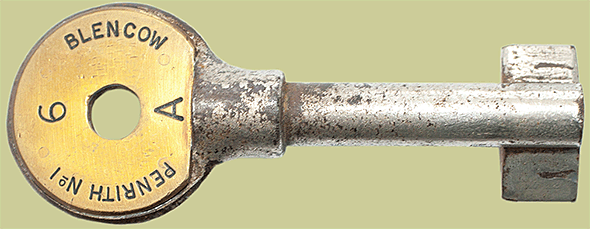
BR selected the Workington – Keswick – Penrith line for revitalisation, and it was one of the first in Great Britain to be transformed from steam to diesel multiple unit (DMU) operation of passenger services. DMUs were introduced on 3 January 1955, and by spring 1956 there were eight each way on weekdays. As part of this project Blencow station reopened on 2 July 1956 – openings and re-openings of stations at that time were exceedingly rare; Camerton remained closed. The station (which had continued to handle goods traffic) was staffed, but the timetable note (see summer 1958, below) that the earliest and latest trains call only to set down passengers presumably indicates that the booking office was staffed only between about 8.00am and 7.00pm.
Up trains: weekdays
9 Jun to 14 Sep 1958 |
Destination |
Down trains: weekdays |
Destination |
8.20am |
Carlisle |
7.26am ᴪ |
Workington |
11.05am |
Carlisle |
10.28am |
Workington |
12.43pm |
Penrith |
11.52am SX |
Workington |
1.42pm |
Carlisle |
12.21pm SO |
Workington |
2.40pm |
Penrith |
1.41pm † |
Workington |
4.19pm |
Penrith |
3.43pm |
Workington |
6.48pm |
Carlisle |
5.18pm |
Workington |
8.02pm ᴪ |
Carlisle |
5.53pm SX ø |
Workington |
- |
- |
5.53pm SO ¶ |
Whitehaven |
- |
- |
6.16pm SX § |
Workington |
- |
- |
6.16pm SO‡ |
Whitehaven |
- |
- |
8.30pm ᴪ |
Workington |
No Sunday service
ᴪ Calls to set down only † 1 minute earlier on Saturday
ø 7 July to 15 September ¶ Until 6 September
§ Until 4 July and 8 to 12 September ‡ 13 September only
The station, along with most of the others on the Workington – Penrith line, was fitted with BR(LM) maroon vitreous enamel nameboards and totem lamp tablets, probably in the late 1950s. Although the station had been gas-lit since 1899 the lanterns in use after the station’s temporary closure possibly held oil lamps. The first photograph that the author took at a station was of such a lamp and totem at Blencow in July 1962.
Up trains: weekdays
14 June 1965 to 17 April 1966 |
Destination |
Down trains: weekdays |
Destination |
08.18 |
Carlisle |
07.27 ᴪ |
Workington |
10.36 |
Carlisle |
09.41 |
Workington |
13.08 |
Penrith |
11.45 |
Keswick |
13.40 |
Carlisle |
13.43 |
Workington |
16.35 |
Carlisle ¶ |
17.08 |
Workington |
19.25 ᴪ |
Penrith |
18.18 |
Workington |
20.24 ᴪ |
Carlisle |
19.54 ᴪ |
Workington |
No Sunday service
ᴪ Calls to set down only
¶ Terminates at Penrith Friday and Saturday 18 June to 4 September
From 1 June 1964 Blencow station ceased to handle goods traffic.
 In 1964 Jim Airey, who had been stationmaster at Bassenthwaite Lake, took charge of Blencow. He remained in post until 1966 and was to be the last stationmaster. On 28 June 1965 the refuge siding, dock siding and the other down yard facilities were taken out of use, but the down refuge siding was restored from 4 December 1967. The line from Keswick through Cockermouth to Workington lost its passenger service on 18 April 1966 and the remaining Penrith – Keswick section was demoted to ‘One Engine in Steam’ working on 4 December 1967 leaving only one track in use. At Blencow the up line and platform (by now without a shelter) was retained for passenger train use so the down platform where the main building was located was abandoned. For several years the down track remained in place as far as the west end of the station. In the mid 1960s an electric lamp was placed at the east end of both platforms, replacing the oil lighting. In 1964 Jim Airey, who had been stationmaster at Bassenthwaite Lake, took charge of Blencow. He remained in post until 1966 and was to be the last stationmaster. On 28 June 1965 the refuge siding, dock siding and the other down yard facilities were taken out of use, but the down refuge siding was restored from 4 December 1967. The line from Keswick through Cockermouth to Workington lost its passenger service on 18 April 1966 and the remaining Penrith – Keswick section was demoted to ‘One Engine in Steam’ working on 4 December 1967 leaving only one track in use. At Blencow the up line and platform (by now without a shelter) was retained for passenger train use so the down platform where the main building was located was abandoned. For several years the down track remained in place as far as the west end of the station. In the mid 1960s an electric lamp was placed at the east end of both platforms, replacing the oil lighting.
In April 1966 following the closure of the line west of Keswick, Mr & Mrs Edwin Thompson, who had both worked on the closed section, moved into the station house at Blencow, and Mr Thompson worked the signal box here until it closed on 4 December 1967.

Further economies were effected on 1 July 1968 when Blencow and all of the other branch stations, including the terminus at Keswick, ceased to be staffed. In early 1970 BR published a proposal to close the line. The passenger service shown below would prove to be the last as on 6 March 1972 the Keswick branch closed to passengers.
Up trains: weekdays
3 May 1971 |
Destination |
Down trains: weekdays |
Destination |
08.10 |
Carlisle |
06.59 |
Keswick |
11.35 |
Penrith |
10.05 |
Keswick |
13.45 |
Penrith |
12.19 |
Keswick |
16.00 |
Penrith |
14.24 |
Keswick |
17.35 |
Penrith |
16.34 |
Keswick |
19.35 |
Carlisle |
18.34 |
Keswick |
No Sunday service
 Goods trains continued to pass through Blencow for several months between Penrith and Flusco Quarry, located between Blencow and Penruddock. However this traffic ended on 19 June 1972. The Thompsons remained at Blencow station after it closed; they extended the station house, taking in the former down platform building and creating an informal museum of CK&P memorabilia. Goods trains continued to pass through Blencow for several months between Penrith and Flusco Quarry, located between Blencow and Penruddock. However this traffic ended on 19 June 1972. The Thompsons remained at Blencow station after it closed; they extended the station house, taking in the former down platform building and creating an informal museum of CK&P memorabilia.
Route map drawn by Alan Young. Totem from Richard Furness. Timetable from Alan Young. Dr Richard Oliver of the Charles Close Society provided suggestions concerning the interpretation of the nineteenth-century OS plans.
To see the other
stations on the Cockermouth - Penrith line click on the station name: Cockermouth 1st, Cockermouth 2nd, Embleton, Bassenthwaite Lake, Braithwaite, Keswick, Briery Siding Halt, Threlkeld, Highgate Platform, Troutbeck& Penruddock
Click here for a brief history of the Cockermouth, Keswick and Penrith Railway |

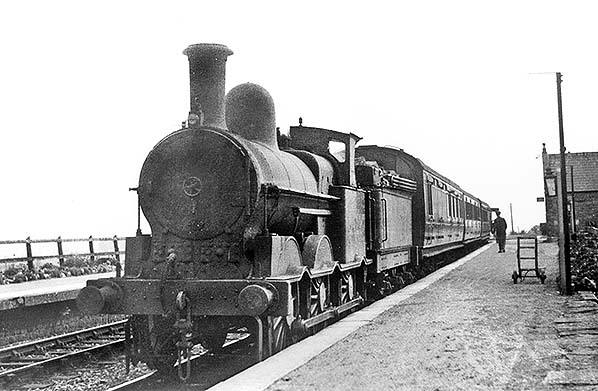

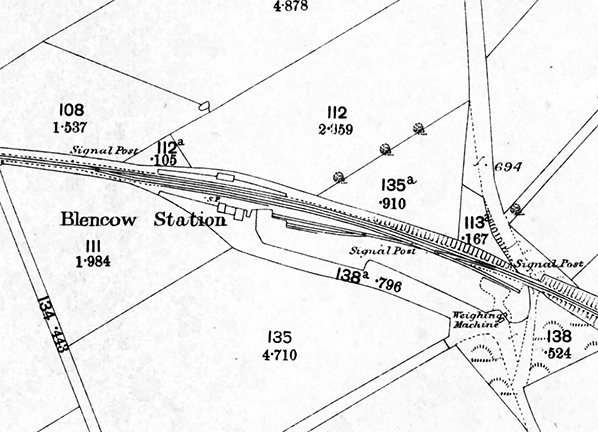
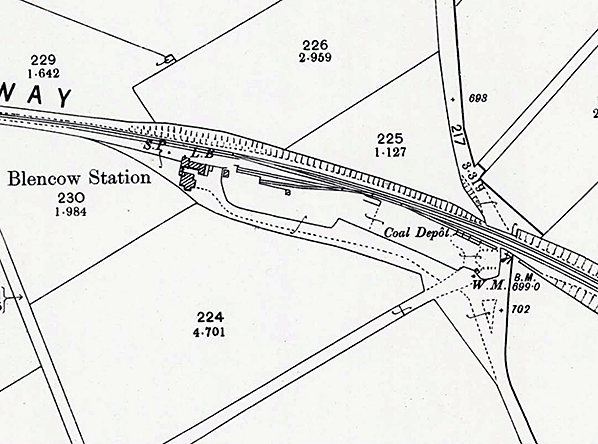
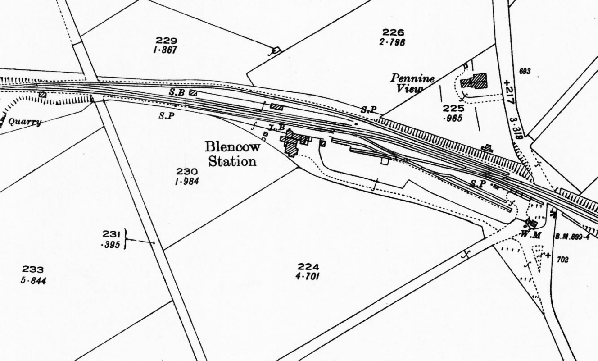 1925 1: 2,500 OS map. Since the 1859 map major additions have been made to the main down side building. An up goods loop has been installed behind the up platform permitting goods trains (for example carrying lime from Flusco Quarry) to be held while an up passenger train calls at the station. A signal box (opened in 1901) is provided at the west end of the up platform. Sidings have been added on the down side. The layout is shown prior to the opening of Blencowe Lime Works: see
1925 1: 2,500 OS map. Since the 1859 map major additions have been made to the main down side building. An up goods loop has been installed behind the up platform permitting goods trains (for example carrying lime from Flusco Quarry) to be held while an up passenger train calls at the station. A signal box (opened in 1901) is provided at the west end of the up platform. Sidings have been added on the down side. The layout is shown prior to the opening of Blencowe Lime Works: see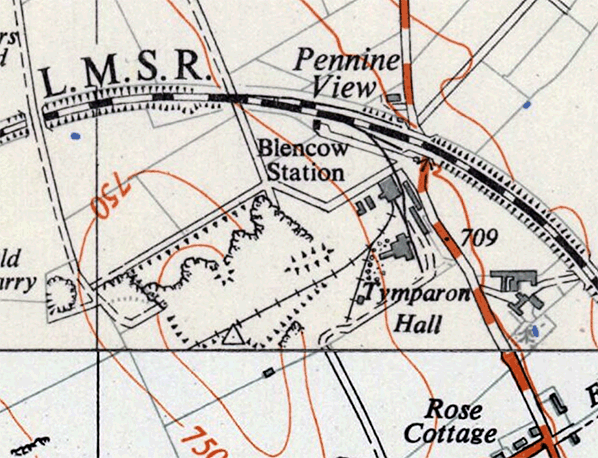
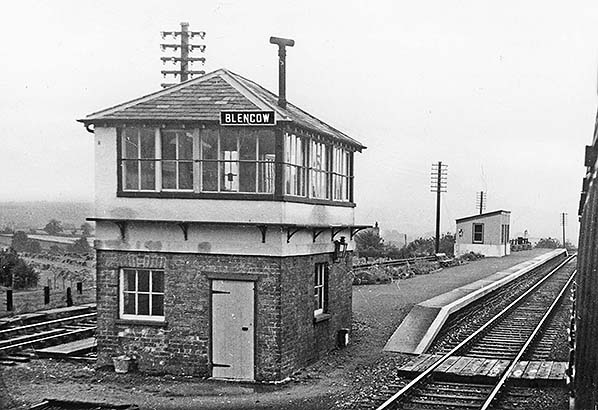
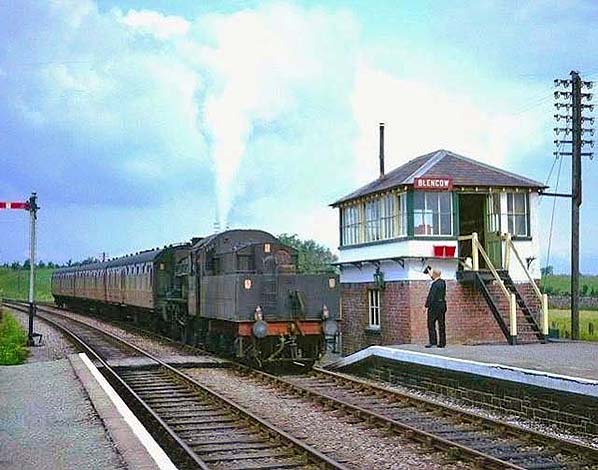
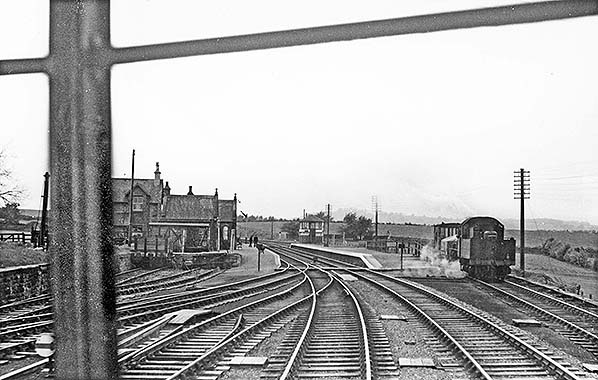
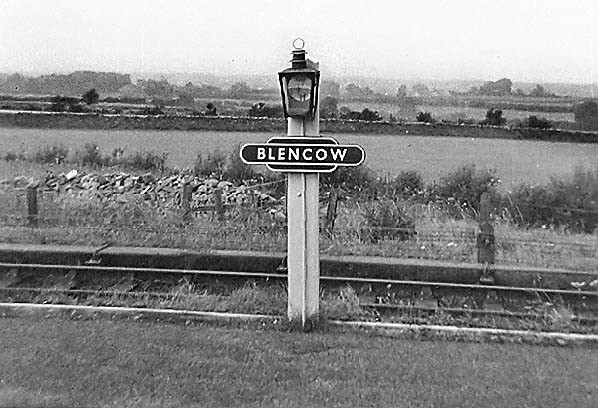
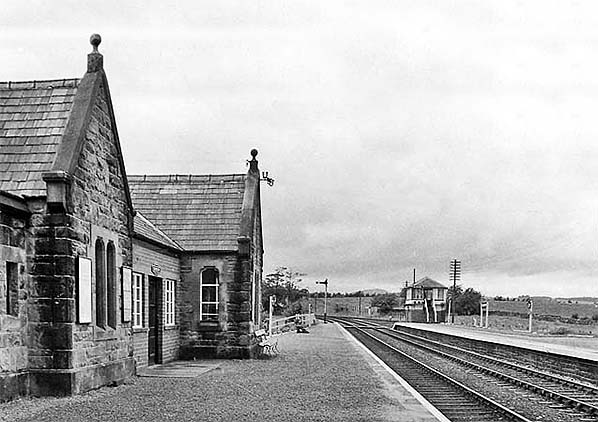 Blencow station looking west from the down platform in September 1962. . The entrance to the station is through the doorway between the two protruding gables; a totem sign is seen above the doorway. One of the gables protrudes further onto the platform, this was the stationmaster's office and side windows in the gable gave the stationmaster a good view along the platforms.
Blencow station looking west from the down platform in September 1962. . The entrance to the station is through the doorway between the two protruding gables; a totem sign is seen above the doorway. One of the gables protrudes further onto the platform, this was the stationmaster's office and side windows in the gable gave the stationmaster a good view along the platforms.
 Blencow station originally possessed a single platform on the down (south) side of the line. The single-storey stone building was a handsome ‘twin pavilion’ structure, not unlike the style used by the Midland Railway in the 1870s but for some reason quite different from the other minor CK&P buildings. Each of the two protruding gables was pierced by a pair of arched openings divided by a mullion and a stone finial decorated the summits of the gables. An office and two waiting rooms were provided in the building. Close behind it stood the stationmaster’s house, a two-storey structure designed by John Ross, architect to the CK&P and constructed by J R Harrison. The station was initially oil lit, but the CK&P was unusual in deciding to install acetylene generators even at its minor stations. One was fitted at Blencow (recycled from Penruddock in August 1899) in a ‘gas house’ added to the western end of the platform building. Two years later more powerful equipment replaced the original plant. A separate structure further west was used to store carbide.
Blencow station originally possessed a single platform on the down (south) side of the line. The single-storey stone building was a handsome ‘twin pavilion’ structure, not unlike the style used by the Midland Railway in the 1870s but for some reason quite different from the other minor CK&P buildings. Each of the two protruding gables was pierced by a pair of arched openings divided by a mullion and a stone finial decorated the summits of the gables. An office and two waiting rooms were provided in the building. Close behind it stood the stationmaster’s house, a two-storey structure designed by John Ross, architect to the CK&P and constructed by J R Harrison. The station was initially oil lit, but the CK&P was unusual in deciding to install acetylene generators even at its minor stations. One was fitted at Blencow (recycled from Penruddock in August 1899) in a ‘gas house’ added to the western end of the platform building. Two years later more powerful equipment replaced the original plant. A separate structure further west was used to store carbide. 
 In 1908 a pair of cottages was built at Blencow by the CK&P, one for the signalman and the other for the permanent way ganger in charge of the length west of Blencow station. These cottages stand adjacent to the road east of the station.
In 1908 a pair of cottages was built at Blencow by the CK&P, one for the signalman and the other for the permanent way ganger in charge of the length west of Blencow station. These cottages stand adjacent to the road east of the station.

 In 1964 Jim Airey, who had been stationmaster at Bassenthwaite Lake, took charge of Blencow. He remained in post until 1966 and was to be the last stationmaster. On 28 June 1965 the refuge siding, dock siding and the other down yard facilities were taken out of use, but the down refuge siding was restored from 4 December 1967. The line from Keswick through Cockermouth to Workington lost its passenger service on 18 April 1966 and the remaining Penrith – Keswick section was demoted to ‘One Engine in Steam’ working on 4 December 1967 leaving only one track in use. At Blencow the up line and platform (by now without a shelter) was retained for passenger train use so the down platform where the main building was located was abandoned. For several years the down track remained in place as far as the west end of the station. In the mid 1960s an electric lamp was placed at the east end of both platforms, replacing the oil lighting.
In 1964 Jim Airey, who had been stationmaster at Bassenthwaite Lake, took charge of Blencow. He remained in post until 1966 and was to be the last stationmaster. On 28 June 1965 the refuge siding, dock siding and the other down yard facilities were taken out of use, but the down refuge siding was restored from 4 December 1967. The line from Keswick through Cockermouth to Workington lost its passenger service on 18 April 1966 and the remaining Penrith – Keswick section was demoted to ‘One Engine in Steam’ working on 4 December 1967 leaving only one track in use. At Blencow the up line and platform (by now without a shelter) was retained for passenger train use so the down platform where the main building was located was abandoned. For several years the down track remained in place as far as the west end of the station. In the mid 1960s an electric lamp was placed at the east end of both platforms, replacing the oil lighting.
 Goods trains continued to pass through Blencow for several months between Penrith and Flusco Quarry, located between Blencow and Penruddock. However this traffic ended on 19 June 1972. The Thompsons remained at Blencow station after it closed; they extended the station house, taking in the former down platform building and creating an informal museum of CK&P memorabilia.
Goods trains continued to pass through Blencow for several months between Penrith and Flusco Quarry, located between Blencow and Penruddock. However this traffic ended on 19 June 1972. The Thompsons remained at Blencow station after it closed; they extended the station house, taking in the former down platform building and creating an informal museum of CK&P memorabilia. 
 Home Page
Home Page